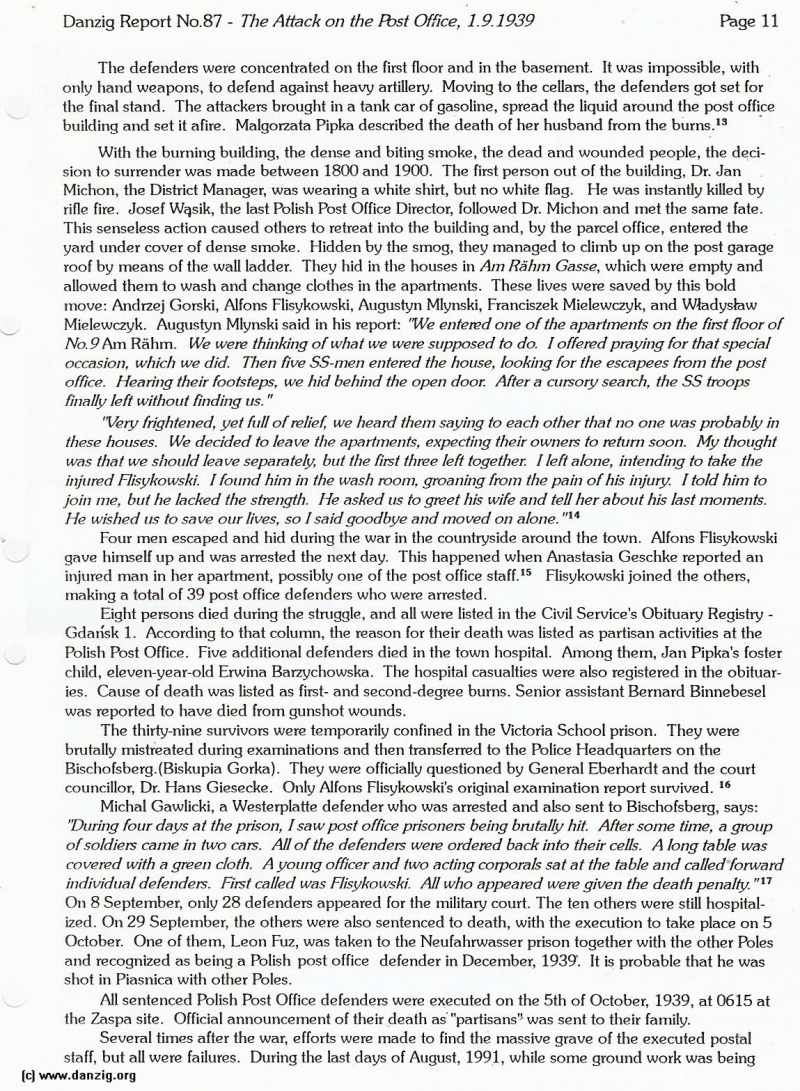
The defenders were concentrated on the first floor and in the basement. It was impossible, with only hand weapons, to defend against heavy artillery. Moving to the cellars, the defenders got set for the final stand. The attackers brought in a tank car of gasoline, spread the liquid around the post office building and set it afire. Malgorzata Pipka described the death of her husband from the burns.13
With the burning building, the dense and biting smoke, the dead and wounded people, the decis ion to surrender was made between 1800 and 1900. The first person out of the building, Dr. Jan Michon, the District Manager, was wearing a white shirt, but no white flag. I-he was instantly killed by rifle fire. Josef Wsik, the last Polish Post Office Director, followed Dr. Michion and met the same fate. This senseless action caused others to retreat into the building and, by the parcel office, entered the yard under cover of dense smoke. Hidden by the smog, they managed to climb up on the post garage roof by means of the wall ladder. They hid in the houses in Am Rabin Gasse, which were empty and allowed them to wash and change clothes in the apartments. These lives were saved by this bold move: Andrzej Gorski, Alfons Flisykowski, Augustyn Mlynski, Franciszek Mielewczyk, and Whadyslaw Mielewczyk. Augustyn Mlynski said in his report: ‘We entered one of the apartments on the first floor of No.9 Am Ráhm. We were thinking of what tve were supposed to do. I offered praying for that special occasion, which we did. Then live SS-men entered the house, looking for the escapees Iron; the post office. Hearing their footsteps, we hid behind the open door. After a cursory search, the SS troops fiuially left without finding us.”
‘
Very fnqhte,ied, yet full of relief we heard them saying to each other that no one was probably in these houses. We decided to leave the apartments, expecting thefr owners to return soon. My thought was that we should leave separately, bitt the first three left together. Ileft alone, intending to take the h/iired Flisykowski. I found him in the wash room, groaning from the pail; of his injury. I told him to join me, but he lacked the strength. He asked us to greet his wife and tell her about his last moments. He wished its to save our lives, so I said goodbye and mo tied oi; alone. “14
Four men escaped and hid during the war in the countryside around the town. Alfons Flisykowski gave himself up and was arrested the next day. This happened when Anastasia Geschke reported an injured man in her apartment, possibly one of the post office staff.’5 Flisykowski joined the others, making a total of 39 post office defenders who were arrested.
Eight persons died during the struggle, and all were listed in the Civil Service’s Obituary Registry - Gdat{sk 1. According to that column, the reason for their death was listed as partisan activities at the Polish Post Office. Five additional defenders died in the town hospital. Among them, Jan Pipka’s foster child, eleven-year-old Erwina Barzychowska. The hospital casualties were also registered in the obituari es. Cause of death was listed as first- and second-degree burns. Senior assistant Bernard Binnebesel was reported to have died from gunshot wounds.
The thirty-nine survivors were temporarily confined in the Victoria School prison. They were brutally mistreated during examinations and then transferred to the Police Headquarters on the Bischofsberg.(Biskupia Gorka). They were officially questioned by General Eberhardt and the court councillor, Dr. Hans Giesecke. Only Alfons Flisykowski’s original examination report survived. 16
Michal Gawlicki, a Westerplatte defender who was arrested and also sent to Bischofsberg, says: ‘During four days at the prison, Isaw post office prisoners being brutally hit. After some time, a group of soldiers came in two cars. All of the defenders were ordered back into thefr cells. A long table was covered with a green cloth. A young officer and two acting corporals sat at the table arid called forward individual defenders. First called was Flisykowski. All who appeared were given the death penalty”7 On 8 September, only 28 defenders appeared for the military court. The ten others were still hospitali zed. On 29 September, the others were also sentenced to death, with the execution to take place on 5 October. One of them, Leon Fuz, was taken to the Neufahrwasser prison together with the other Poles and recognized as being a Polish post office defender in December, 193g. It is probable that he was shot in Piasnica with other Poles.
All sentenced Polish Post Office defenders were executed on the 5th of October, 1939, at 0615 at the Zaspa site. Official announcement of their death as’ “partisans’s was sent to their family.
Several times after the war, efforts were made to find the massive grave of the executed postal staff, but all were failures. During the last days of August, 1991, while some ground work was being
Danzig Report Vol. 1 - Nr. 87 - April - May - June - 1995, Page 11.
Hits: 3915
Added: 11/07/2015
Copyright: 2025 Danzig.org

